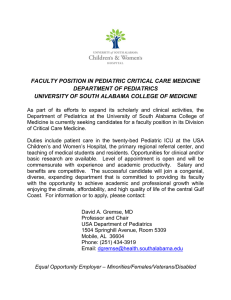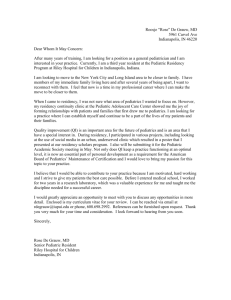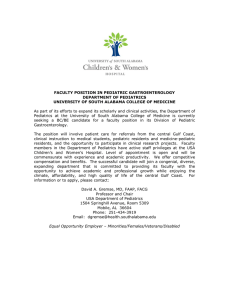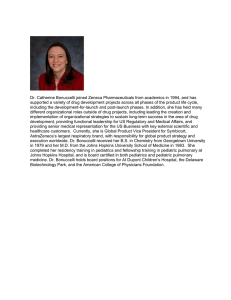ABSTRACT: 2014 ELAM Institutional Action Project Poster Symposium
advertisement
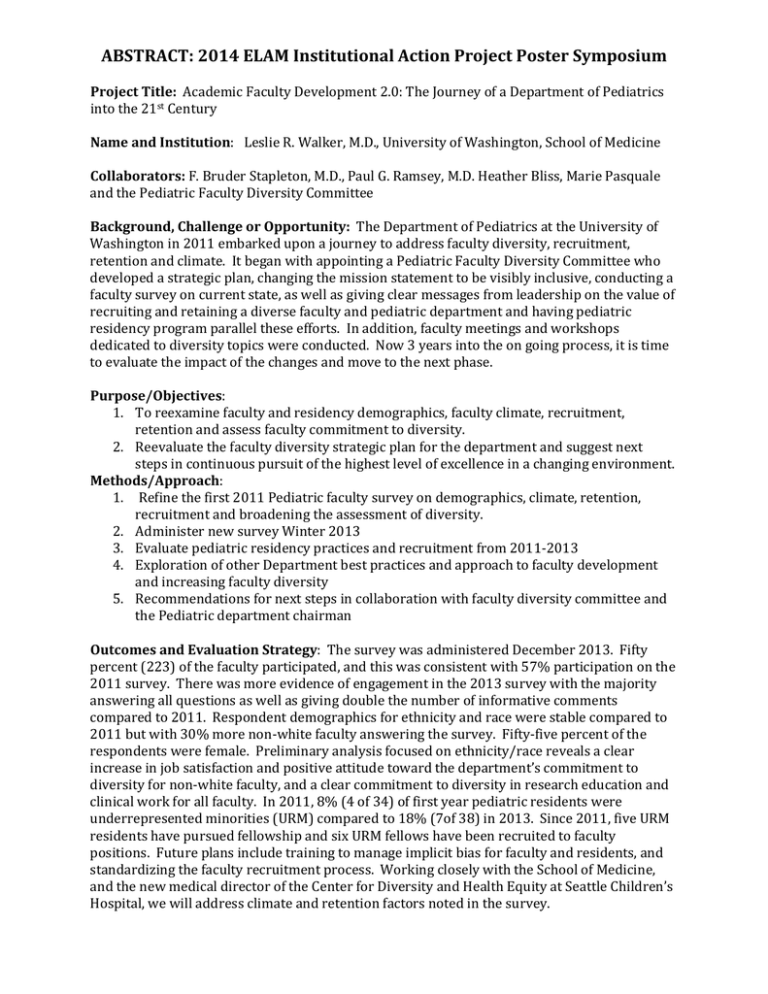
ABSTRACT: 2014 ELAM Institutional Action Project Poster Symposium Project Title: Academic Faculty Development 2.0: The Journey of a Department of Pediatrics into the 21st Century Name and Institution: Leslie R. Walker, M.D., University of Washington, School of Medicine Collaborators: F. Bruder Stapleton, M.D., Paul G. Ramsey, M.D. Heather Bliss, Marie Pasquale and the Pediatric Faculty Diversity Committee Background, Challenge or Opportunity: The Department of Pediatrics at the University of Washington in 2011 embarked upon a journey to address faculty diversity, recruitment, retention and climate. It began with appointing a Pediatric Faculty Diversity Committee who developed a strategic plan, changing the mission statement to be visibly inclusive, conducting a faculty survey on current state, as well as giving clear messages from leadership on the value of recruiting and retaining a diverse faculty and pediatric department and having pediatric residency program parallel these efforts. In addition, faculty meetings and workshops dedicated to diversity topics were conducted. Now 3 years into the on going process, it is time to evaluate the impact of the changes and move to the next phase. Purpose/Objectives: 1. To reexamine faculty and residency demographics, faculty climate, recruitment, retention and assess faculty commitment to diversity. 2. Reevaluate the faculty diversity strategic plan for the department and suggest next steps in continuous pursuit of the highest level of excellence in a changing environment. Methods/Approach: 1. Refine the first 2011 Pediatric faculty survey on demographics, climate, retention, recruitment and broadening the assessment of diversity. 2. Administer new survey Winter 2013 3. Evaluate pediatric residency practices and recruitment from 2011-2013 4. Exploration of other Department best practices and approach to faculty development and increasing faculty diversity 5. Recommendations for next steps in collaboration with faculty diversity committee and the Pediatric department chairman Outcomes and Evaluation Strategy: The survey was administered December 2013. Fifty percent (223) of the faculty participated, and this was consistent with 57% participation on the 2011 survey. There was more evidence of engagement in the 2013 survey with the majority answering all questions as well as giving double the number of informative comments compared to 2011. Respondent demographics for ethnicity and race were stable compared to 2011 but with 30% more non-white faculty answering the survey. Fifty-five percent of the respondents were female. Preliminary analysis focused on ethnicity/race reveals a clear increase in job satisfaction and positive attitude toward the department’s commitment to diversity for non-white faculty, and a clear commitment to diversity in research education and clinical work for all faculty. In 2011, 8% (4 of 34) of first year pediatric residents were underrepresented minorities (URM) compared to 18% (7of 38) in 2013. Since 2011, five URM residents have pursued fellowship and six URM fellows have been recruited to faculty positions. Future plans include training to manage implicit bias for faculty and residents, and standardizing the faculty recruitment process. Working closely with the School of Medicine, and the new medical director of the Center for Diversity and Health Equity at Seattle Children’s Hospital, we will address climate and retention factors noted in the survey. Academic Faculty Development 2.0 : st The Journey of a Department of Pediatrics into the 21 Century Leslie R. Walker, M.D., Department of Pediatrics University of Washington, School of Medicine OUTCOMES AND EVALUATION Faculty Composition CHALLENGE As the population in the United States moves into the 21st century, rapidly changing demographics have underscored the need for the medical system to respond in new and different ways to decrease health disparities and achieve health equity for all. This is particularly visible in the pediatric population, where demographic changes have already occurred. Academic Pediatrics has struggled to recruit and retrain a diverse faculty workforce with fresh perspectives that can meet the needs of the evolving population. To reexamine faculty and residency demographics, faculty climate, recruitment, retention and assess faculty commitment to diversity. 13% 15% 5% 1% 3% 0% 5% White Does the department as a whole embrace diversity and inclusiveness? Academic Rank 60 60 50 50 40 Male Female 30 Asian Non White 20 White 40 Somewhat Agree 30 20 Bibliography Castillo-Page L. Diversity in Medical Education: Facts & Figures 2012 Association of American Medical Colleges, Diversity Policy and Programs. Fall 2012 Walker LR, Stapleton B. Pediatric Faculty Diversity: A New Landscape for Academic Pediatrics in the 21st Century. JAMA Pediatrics 2013; 167 (11); 989 Definitely Disagree 2011 Instructor Acting Assistant Professor Assistant Professor Assoiciate Professor Professor 2013 Asian 2011 2013 Non White 2011 2013 White Does the Department leadership publicly emphasize the importance of diversity/inclusiveness? 60 50 40 Percentage Preliminary analysis reveals a positive change in attitude toward the department’s commitment to diversity for non-white faculty, and the importance of diversity to the Department as well as some modest change in faculty and resident demographics. Informant review of 5 School of Medicine Departments suggested high retention and supportive climate was proportional to leadership recognition and mentorship of faculty and increased diversity was related to transparent recruitment process standards CONCLUSIONS A sustained stepwise collaborative department level effort to increase value on achieving a diverse workforce and inclusive climate is achievable with leadership commitment and accountability Future plans include training to manage implicit bias for faculty and residents, and standardizing the faculty recruitment process. After committee analysis, present findings of survey to faculty June 2, 2014 Working closely with the School of Medicine, and the new medical director of the Center for Diversity and Health Equity at Seattle Children’s Hospital, we will use evidence based methods for continued faculty engagement in implementation of systems that promote a supportive climate of opportunity for a diverse faculty in the Department of Pediatrics and Hospital. Somewhat Disagree 0 Administer new survey Winter 2013 Recommendations for next steps in collaboration with faculty diversity committee and the Pediatric department chairman Neutral 10 10 Refine the first 2011 Pediatric faculty survey on demographics, climate, retention, recruitment and broadening the assessment of diversity. Exploration of other Department best practices and approach to faculty development and increasing faculty diversity Definitely Agree Unsure/Don't Know APPROACH Evaluate pediatric residency practices and recruitment from 20112013 1% 4% 1% Other 0 Reevaluate the faculty diversity strategic plan for the department and suggest next steps in continuous pursuit of the highest level of excellence in a changing environment Black or African American American Indian or Alaska Native Hispanic or Latino 74% 78% Percentage PURPOSE/OBJECTIVES Asian Percentage The Department of Pediatrics at the University of Washington in 2011 embarked upon a journey to address faculty diversity, recruitment, retention and climate. It began with appointing a Pediatric Faculty Diversity Committee who developed a strategy for addressing organizational change, the mission statement was updated to be visibly inclusive, a faculty survey on current state was conducted, as well as clear messages from leadership focused on the value of recruiting and retaining a diverse faculty. The pediatric residency program paralleled these efforts. In addition, faculty meetings and workshops dedicated to diversity topics were conducted. Now 3 years into the process, it is time to evaluate the impact of the changes and move to the next phase. 2013 2011 Definitely Agree 30 Somewhat Agree Somewhat Disagree Definitely Disagree 20 Pediatric Residency Recruitment Self-Identification American Indian Asian and Asian Indian Black Mexico/Chicano Native Hawaiian/PI Other* Prefer Not To Say Puerto Rican White Total URM 2011 Interns 0 4 1 2 0 0 2 0 25 34 3 (8.8%) 2012 Interns 0 2 2 2 0 0 5 1 26 38 5(13%) 2013 Interns 1 4 2 3 0 1 3 1 23 38 7 (18%) Gender 2011 Interns 2012 Interns 2013 Interns Male Female Other/Prefer Not To Say Total 8 26 0 34 12 26 0 38 15 23 0 38 10 0 2011 2013 Asian 2011 2013 Non White 2011 2013 White Special Acknowledgement to collaborators: Bruder Stapleton, M.D., Paul G. Ramsey, M.D. Heather Bliss, Marie Pasquale and the Pediatric Faculty Diversity Committee Presented at the 2014 ELAM® Leaders Forum
